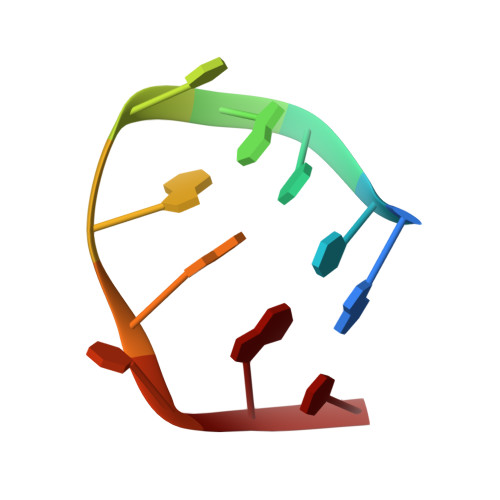Structural Basis for Bifunctional Zinc(II) Macrocyclic Complex Recognition of Thymine Bulges in DNA.
Del Mundo, I.M., Siters, K.E., Fountain, M.A., Morrow, J.R.(2012) Inorg Chem 51: 5444-5457
- PubMed: 22507054
- DOI: https://doi.org/10.1021/ic3004245
- Primary Citation of Related Structures:
2LO5, 2LO8, 2LOA - PubMed Abstract:
The zinc(II) complex of 1-(4-quinoylyl)methyl-1,4,7,10-tetraazacyclododecane (cy4q) binds selectively to thymine bulges in DNA and to a uracil bulge in RNA. Binding constants are in the low-micromolar range for thymine bulges in the stems of hairpins, for a thymine bulge in a DNA duplex, and for a uracil bulge in an RNA hairpin. Binding studies of Zn(cy4q) to a series of hairpins containing thymine bulges with different flanking bases showed that the complex had a moderate selectivity for thymine bulges with neighboring purines. The dissociation constants of the most strongly bound Zn(cy4q)-DNA thymine bulge adducts were 100-fold tighter than similar sequences with fully complementary stems or than bulges containing cytosine, guanine, or adenine. In order to probe the role of the pendent group, three additional zinc(II) complexes containing 1,4,7,10-tetraazacyclododecane (cyclen) with aromatic pendent groups were studied for binding to DNA including 1-(2-quinolyl)methyl-1,4,7,10-tetraazacyclododecane (cy2q), 1-(4-biphenyl)methyl-1,4,7,10-tetraazacyclododecane (cybp), and 5-(1,4,7,10-tetraazacyclododecan-1-ylsulfonyl)-N,N-dimethylnaphthalen-1-amine (dsc). The Zn(cybp) complex binds with moderate affinity but little selectivity to DNA hairpins with thymine bulges and to DNA lacking bulges. Similarly, Zn(dsc) binds weakly both to thymine bulges and hairpins with fully complementary stems. The zinc(II) complex of cy2q has the 2-quinolyl moiety bound to the Zn(II) center, as shown by (1)H NMR spectroscopy and pH-potentiometric titrations. As a consequence, only weak (500 μM) binding is observed to DNA with no appreciable selectivity. An NMR structure of a thymine-bulge-containing hairpin shows that the thymine is extrahelical but rotated toward the major groove. NMR data for Zn(cy4q) bound to DNA containing a thymine bulge is consistent with binding of the zinc(II) complex to the thymine N3(-) and stacking of the quinoline on top of the thymine. The thymine-bulge bound zinc(II) complex is pointed into the major groove, and there are interactions with the guanine positioned 5' to the thymine bulge.
Organizational Affiliation:
Department of Chemistry, University at Buffalo, State University of New York, Buffalo, New York 14260, USA.
















